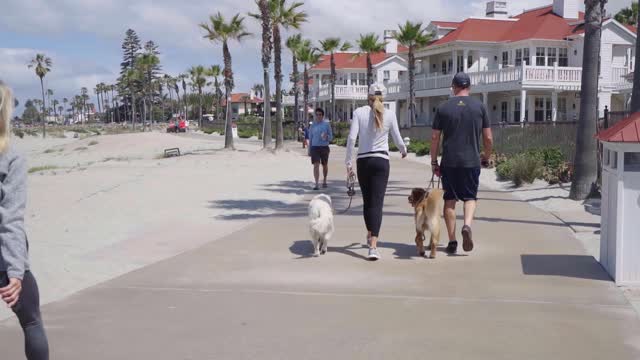Premium Only Content

How dogs use their sense of smell to perceive the world.
How dogs use their sense of smell to perceive the world.
The nose is a prominent canine facial feature...long, short, black, pink. Noses vary, but they all have one thing in common. Noses are fundamental to canine survival.
The canine nose does more than smell the roses. While humans rely primarily on their vision, dogs use both sight and smell to assess their environment and communicate. People spend more time interpreting visual data than olfactory information. Dogs are just the opposite.
Dogs devote a lot of brain power to interpreting smells. They have more than 100 million sensory receptor sites in the nasal cavity compared to 6 million in people, and the area of the canine brain devoted to the analysis of odors is about 40 times larger than the comparable part of the human brain. In fact, it is estimated that dogs can smell 1,000 to 10,000 times better than people.
Although noses don't talk, they do communicate. With a single sniff, noses interpret an entire story without words using amines and acids emitted by dogs as the basis for chemical communication. Chemical scents communicate what a dog likes to eat and identify gender and mood. Simply by smelling, a dog can determine whether a new friend is male or female, happy or aggressive, healthy or sick. Dogs get a general idea of each other with a quick sniff, but they get more detailed information by getting up close and personal. That's why some dogs smell intimate parts of the anatomy!
Dogs also have a good olfactory memory that can identify other dogs they haven't seen in years and even remember which one was the dominant member of the couple. When dogs belonging to the same family are separated for a while, they use their sense of smell to catch up. Changes in odors can indicate where the dog went, what he ate, and what he did.
When in new territory, a dog may smell a tree and determine which other dogs live in the neighborhood. They can smell a visitor's pant leg and get a good impression of where the person lives and whether they have pets at home.
Dogs also have a great search instinct that depends on their ability to smell. Because dogs move their nostrils independently, they can determine the direction of an odor and use their sense of smell as a compass.
Humans have a unique innate smell that allows dogs to differentiate one person from another. Our dogs don't need to see us to identify us. A dog's sense of smell is so adept that a blind dog has much less difficulty adjusting to vision loss than a human.
Dogs also sense fear and anxiety through their noses. When we are stressed or frightened, we secrete the fight-or-flight hormone, adrenaline, which dogs detect even if we can't smell it. When we are anxious, we also increase our heart rate and blood flow, which carry chemicals from the body to the surface of the skin, where dogs can pick them up more easily. So it's no use trying to mask your true feelings from your canine companion. His sense of smell will not be deceived.
Unlike humans, dogs have an additional olfactory tool that enhances their ability to smell. Jacobsen's organ (or vomeronasal organ) is a special part of the dog's olfactory apparatus located inside the nasal cavity and opens in the roof of the mouth behind the upper incisors. This amazing organ serves as a secondary olfactory system designed specifically for chemical communication. The nerves of Jacobsen's organ lead directly to the brain and are different from other nerves in the nose in that they do not respond to common smells. In fact, these nerve cells respond to a number of substances that often have no odor at all. In other words, they work to detect "undetectable" odors.
Jacobsen's organ communicates with the part of the brain that deals with mating. By identifying pheromones, it provides male and female dogs with the information needed to determine whether a member of the opposite sex is available for breeding. It also enhances a newborn puppy's sense of smell so that it can find its mother's milk source and allows a puppy to differentiate its mother from other nursing dogs. With a quick sniff, a puppy placed between two females will migrate to the mother who gave birth to it. Puppies also have heat sensors in their noses that help them locate their mothers if they stray.
The canine nose works best when it is moist. The wet external nose and mucus-covered nasal canal efficiently pick up scent particles. Moisture is so important to the canine sense of smell that dogs lick their noses when they get dry. Smart dogs don't want to miss important information due to a dry nose!
-
 48:16
48:16
Sean Unpaved
2 hours agoDraft Deals, Luka Takes, and Playoff Heat: NFL, NBA, & NHL Ignited
24.3K1 -
 10:33
10:33
Congressman Eli Crane
3 hours agoUnrestricted Warfare: Inside the CCP's Plot to Take Down America
15.3K2 -
 DVR
DVR
FreshandFit
2 days agoCollege Campus Debate
53.7K29 -
 1:02:32
1:02:32
Timcast
2 hours agoSCOTUS Hears Case On LGBTQ Books In Schools As Nike FUNDS Trans Study
135K77 -
 2:02:22
2:02:22
Steven Crowder
5 hours agoRace Conflict: Karmelo Anthony and the Truth About Black & White Relations in America
391K307 -
 1:32:33
1:32:33
Rebel News
2 hours ago $1.94 earnedPoilievre on Canada's 'dangerous future', Singh dodges again, China targets Tory | Rebel Roundup
30.5K7 -
 DVR
DVR
TheAlecLaceShow
3 hours agoGuests: General Flynn & Dr. Michael Schwartz | Pope Francis Died | Hegseth Out? | The Alec Lace Show
18.7K8 -
 32:25
32:25
Adam Carolla
7 hours ago $2.54 earnedMenendez Brothers update and one's tie to Rose O'Donnell | The Adam Carolla Show | #news
37.5K1 -
 1:28:03
1:28:03
The Shannon Joy Show
4 hours ago🔥🔥Hacked & Stacked: Musk Aligned Tech Bros Poised To Cash In On ‘DOGE Hackathon At IRS’ Amidst Growing Health Concerns About Data Processing Centers & EMF Radiation - Special Report On EMF With Dr. Basima Williams🔥🔥
32.3K1 -
 32:00
32:00
Grant Stinchfield
2 hours ago $1.63 earnedDeep State Payday: Fauci’s $15M Windfall Raises Alarms Over COVID Corruption
20.8K4